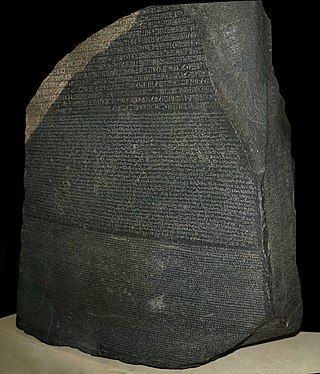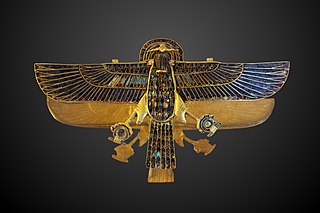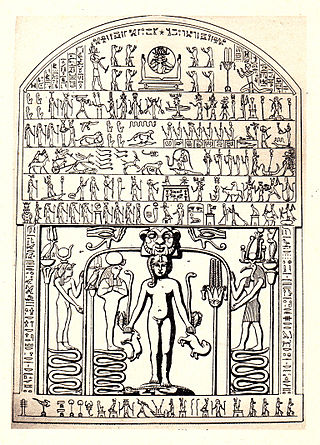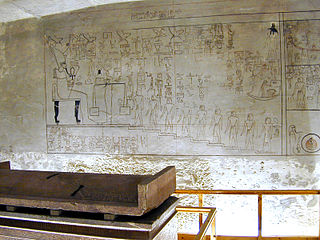
Abydos is one of the oldest cities of ancient Egypt, and also of the eighth nome in Upper Egypt. It is located about 11 kilometres west of the Nile at latitude 26° 10' N, near the modern Egyptian towns of El Araba El Madfuna and El Balyana. In the ancient Egyptian language, the city was called Abedju (Arabic Abdu عبد-و). The English name Abydos comes from the Greek Ἄβυδος, a name borrowed by Greek geographers from the unrelated city of Abydos on the Hellespont. Abydos name in hieroglyphs

The Rosetta Stone is a stele of granodiorite inscribed with three versions of a decree issued in 196 BC during the Ptolemaic dynasty of Egypt, on behalf of King Ptolemy V Epiphanes. The top and middle texts are in Ancient Egyptian using hieroglyphic and Demotic scripts, respectively, while the bottom is in Ancient Greek. The decree has only minor differences across the three versions, making the Rosetta Stone key to deciphering the Egyptian scripts.

Relief is a sculptural method in which the sculpted pieces remain attached to a solid background of the same material. The term relief is from the Latin verb relevare, to raise. To create a sculpture in relief is to give the impression that the sculpted material has been raised above the background plane. When a relief is carved into a flat surface of stone or wood, the field is actually lowered, leaving the unsculpted areas seeming higher. The approach requires a lot of chiselling away of the background, which takes a long time. On the other hand, a relief saves forming the rear of a subject, and is less fragile and more securely fixed than a sculpture in the round, especially one of a standing figure where the ankles are a potential weak point, particularly in stone. In other materials such as metal, clay, plaster stucco, ceramics or papier-mâché the form can be simply added to or raised up from the background. Monumental bronze reliefs are made by casting.

Nectanebo II was the last native ruler of ancient Egypt, as well as the third and last pharaoh of the Thirtieth Dynasty, reigning from 358 to 340 BC.

Ancient Egyptian art refers to art produced in ancient Egypt between the 6th millennium BC and the 4th century AD, spanning from Prehistoric Egypt until the Christianization of Roman Egypt. It includes paintings, sculptures, drawings on papyrus, faience, jewelry, ivories, architecture, and other art media. It was a conservative tradition whose style changed very little over time. Much of the surviving examples comes from tombs and monuments, giving insight into the ancient Egyptian afterlife beliefs.

The Dendera Temple complex is located about 2.5 kilometres (1.6 mi) south-east of Dendera, Egypt. It is one of the best-preserved temple complexes of ancient Egypt. The area was used as the sixth nome of Upper Egypt, south of Abydos.

In ancient Egypt a shen ring was a circle with a line tangent to it, represented in hieroglyphs as a stylised loop of a rope. The word shen itself means, in ancient Egyptian, encircle, while the shen ring represented eternal protection.

The Metternich Stela is a magico-medical Horus on the Crocodiles stele that is part of the Egyptian collection of the Metropolitan Museum of Art in New York City. It dates to the Thirtieth Dynasty of Egypt around 380–342 B.C. during the reign of Nectanebo II. The provenance of the stele is unknown.

The Decree of Canopus is a trilingual inscription in three scripts, which dates from the Ptolemaic period of ancient Egypt. It was written in three writing systems: Egyptian hieroglyphs, demotic, and Koine Greek, on several ancient Egyptian memorial stones, or steles. The inscription is a record of a great assembly of priests held at Canopus, Egypt, on 7 Appellaios (Mac.) = 17 Tybi (Eg.) year 9 of Ptolemy III = Thursday 7 March 238 BC. Their decree honoured Pharaoh Ptolemy III Euergetes; Queen Berenice, his wife; and Princess Berenice.

Nectanebo I was an ancient Egyptian pharaoh, founder of the last native dynasty of Egypt, the 30th.

Tomb KV57 is the royal tomb of Horemheb, the last pharaoh of the Eighteenth Dynasty and is located in the Valley of the Kings, Egypt.

Heracleion, also known as Thonis and sometimes called Thonis-Heracleion, was an ancient Egyptian port city located near the Canopic Mouth of the Nile, about 32 km (20 mi) northeast of Alexandria on the Mediterranean Sea. It became inundated and its remains are located in Abu Qir Bay, currently 7 km (4.3 mi) off the coast, under ca. 19 ft (5.8 m) of water, and near Abukir. The sanctuary of Neith of Sais was located in Thonis. A stele found on the site indicates that late in its history the city was known by both its Egyptian and Greek names.

The Nine Bows is a visual representation in Ancient Egyptian art of foreigners or others. Besides the nine bows, there were no other generic representations of foreigners. Due to its ability to stand in for any nine enemies to Ancient Egypt, the peoples covered by this term changed over time as enemies changed, and there is no true list of the nine bows.

The ancient Egyptian Mast hieroglyph is one of the oldest language hieroglyphs from Ancient Egypt. It is used on a famous label of Pharaoh Den of the First dynasty, but forms part of the location hieroglyph: Emblem of the East.

The ancient Egyptian Man-prisoner is one of the oldest hieroglyphs from Ancient Egypt. An iconographic portrayal from predynastic Egypt eventually led to its incorporation into the writing system of the Egyptian language. Not only rebels from towns or districts, but foreigners from battle were being portrayed.

The Decree of Nectanebo I was issued by Pharaoh Nectanebo I of the 30th Dynasty of Ancient Egypt. It regards payments to the local temple, and was recorded on two steles.

The lunette spatial region in the upper portion of stelas, became common for stelas as a prelude to a stele's topic. Its major use was from ancient Egypt in all the various categories of stelas: funerary, Victory stelas, autobiographical, temple, votive, etc.
The ancient Egyptian Branch hieroglyph, also called a Stick, is a member of the trees and plants hieroglyphs.

The ancient Egyptian Bone-with-meat hieroglyph represented: "ancestry, inherit", and phonetic isw, iw' ; a determinative for the femur, (iw'); and swt, for the tibia.

The Department of Egyptian Antiquities of the Louvre is a department of the Louvre that is responsible for artifacts from the Nile civilizations which date from 4,000 BC to the 4th century. The collection, comprising over 50,000 pieces, is among the world's largest, overviews Egyptian life spanning Ancient Egypt, the Middle Kingdom, the New Kingdom, Coptic art, and the Roman, Ptolemaic, and Byzantine periods.






















